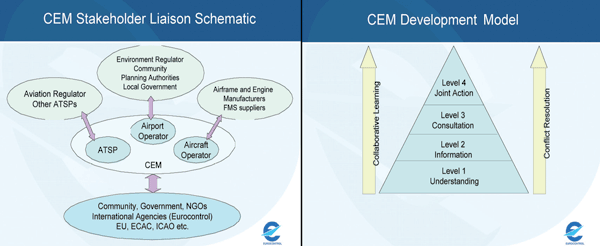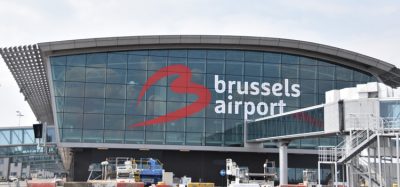Eurocontrol and European airports
Posted: 16 March 2005 | Paul Wilson, Head of Airport Throughput Business Division, Eurocontrol | No comments yet
A recent and very detailed study by Eurocontrol into the evolution of traffic demand revealed some significant information for airports. Known as the Challenges to Growth 2004 Study, this work updated a previous report that was completed in 2001.
A recent and very detailed study by Eurocontrol into the evolution of traffic demand revealed some significant information for airports. Known as the Challenges to Growth 2004 Study, this work updated a previous report that was completed in 2001.
Although future traffic growth can be very difficult to predict due to the possibility of unforeseen external factors, the high forecast over the period of the study, up to 2025, indicated that traffic has the potential to increase by a factor of 2.5. The same report also estimated however, that the airport network has the long term potential of 60% capacity growth using existing or planned infrastructure.
Figures such as these clearly indicate that many airports in the future will need to engage in high intensity runway operations, to ensure that the full potential of the runways are realised and where required, all latent capacity is unlocked.
Join us live: Shaping the Next Generation of Hold Baggage and Air Cargo Screening
Join us live for an insightful webinar on 11th December at 14:00 GMT, in collaboration with Smiths Detection, as we explore the strategic balance of operational efficiency, regulatory compliance, and sustainability in high-volume security environments.
This session offers a focused look into future-proofing your security strategy.
Key learning points
- Cost Reduction: Strategies to minimize bag travel time while simultaneously reducing operational costs.
- Regulatory Roadmap: Insights into the next wave of regulatory changes and their impact on future investment decisions.
- Sustainable Systems: Practical approaches to building sustainability into security systems and lowering the total cost of ownership (TCO).
- Scalable Solutions: Real-world examples of scalable systems supporting current airport growth and preparing for tomorrow.
Register now for expert insights, case studies, and actionable strategies on operational efficiency!
Experience has shown that it can take many years to reach this point where a runway can consistently deliver maximum possible throughput, using minimum permissible separations. There are many issues that must be carefully considered, such as controller and pilot workload, human factors, possible construction of new runway exits and access points and environmental restrictions.
Eurocontrol, which was created in 1960, has traditionally devoted its efforts towards the en-route arena, where capacity restrictions and congestion initially manifested themselves. Within this area there have been significant achievements. Working closely with air navigation service providers and aircraft operators the increase in available capacity has been in the order of 50% over the last few years. Enhancements in the operation of the Central Flow Management Unit and other pan-European projects such as the 8.33mHz frequency division and the reduced vertical separation criteria have delivered huge benefits. The fact that rapid progress was being achieved in the en-route area was recognised, and whilst this work continues, an additional Eurocontrol focus was turned towards airports in the 1990s.
The Eurocontrol approach to airports
For Eurocontrol this was a new experience, and certainly for the first few years was a very difficult road to move along. Eurocontrol had entered a world in which airports operated in a very challenging commercial environment, where there were many differing institutional operating arrangements, where there were growing environmental pressures, and where it seemed new restrictions and new mandatory requirements were a regular feature. Due to the complex and diverse nature of airport operations, it was obvious that in order to make progress a team effort would be needed. This would certainly involve airport operators, both with associations and with individual airports, and to this end many strong links have been established, not least with Airports Council International-Europe (ACI-Europe), who have been instrumental in designing the eventual Eurocontrol Airport Programme. Of equal importance are the air navigation service providers and controller associations, and input from the airlines. This latter point has been achieved extremely effectively by establishing close links with IATA, who have proved very willing to provide input from the airlines, who are of course the main users of the airport airside operation. Finally, very close coordination was undertaken with the European Commission, who continue to initiate an R&D effort related to airport operations. From the outset it was obviously considered essential that the Eurocontrol effort should not duplicate any activities undertaken elsewhere, but where possible should complement them.
Having established these alliances, and understanding the challenging nature of airport operations, the philosophy at the outset was to generate a low cost and operationally focused programme that would assist airports to enhance safety, efficiency and capacity, so that wherever possible the projected traffic demand could be accommodated. Eurocontrol was not going to produce gold plated and expensive solutions, or try and solve a problem that didn’t exist.
In terms of airport operations there are many areas where significant improvements may be possible. Operations in poor weather, which in 2003 accounted for several million minutes of delay is one such area, as are the existing fairly crude wake vortex separation criteria which are a huge constraint to runway capacity.
The many prospective areas were debated with the Airport Operations Team, which is a group of around 70 representative airport stakeholders. After this debate, and following consultation with other airport representatives, the first Eurocontrol Airport Programme was confirmed and initiated in 2001. The areas selected as high priority in this first programme were:
- Enhancing safety by the prevention of runway incursions
- Capacity assessment
- Capacity enhancement
- Capacity planning
- Advanced surface movement guidance and control systems
- Collaborative Decision Making
- The A380 wake vortex separation criteria
- Airport environmental mitigation procedures and measures
Whilst it is recognised that not all areas are covered, this programme was considered to include the high priority items that should be dealt with as soon as possible.
Brief details of these various projects are given below.
Runway incursion prevention
There is around one incursion per day within the European area, and incursions without doubt represent a high risk area, evidenced by a number of actual collisions over recent years.
A very active working group, composed of representatives from all organisations involved in runway operations, has produced the European Action Plan for the Prevention of Runway Incursions. This has been widely distributed and implemented, and the majority of medium and large sized airports now have local runway safety teams in place. This remains a complex problem though, and work is continuing to develop this initiative further. There is close cooperation with the FAA and Air Services Australia, with the objective of achieving total harmonisation of all procedures. Due to the global nature of air transport it is these regional differences that can result in confusion, and which can and have resulted in many runway incursions.
Capacity assessment
Eurocontrol has produced a very sophisticated tool that is known as the Common Agreed Methodology for Airport airside Capacity Assessment (CAMACA) that has been designed to accurately assess the capacity of runways, taxiway and apron areas. This tool is now available and has already been widely used. In particular recognition of the very high cost of building new taxiways or runway exits, an important ‘what if’ was incorporated into CAMACA. This feature can calculate the increase in capacity that would be achieved should any new infrastructure, such as runway rapid exit taxiways, be constructed. The output from this feature can provide valuable input to the cost-benefit assessment of any proposed investments.
Capacity enhancement
The requirement for many runways to increase their throughput as traffic grows is a complex process with many elements that need to be considered. The Eurocontrol Capacity Enhancement project has developed a step by step methodology that will facilitate capacity enhancement. Key to this project, which has already been tested and has produced increases in capacity, is a close working relationship between controllers, pilots and airport operators.
Capacity planning
This project covers the development of a medium term capacity plan that can be implemented over a five year period as traffic increases. Constraints that may restrict capacity such as airspace and environmental considerations are included. Although still under development, this process has been very successfully trialled at two European airports.
Advanced surface movement guidance and control
The problem with the first generation of airport surface radars was that there were no clear guidelines on how they should be used operationally. Executive control is not possible, and they are used to supplement the visual observations of the controller or to provide the ability to monitor traffic in poor visibility.
The new generation of surveillance equipment, which is now commercially available, is very sophisticated and has the ability to carry out many functions. The Eurocontrol activity in this area involves the definition of air traffic control procedures that will allow this equipment to be used to its full potential. The first tranche of procedures are now being trialled at a number of major airports – it is Eurocontrol’s intention to submit these to ICAO for global adoption towards the end of 2005.
Collaborative Decision Making (CDM)
Whilst airports can be awash with data and information, it is a fact that this information is not always available to those who need it. In simple terms this project is about delivering up to date information to the people who need it at the correct time, which will then significantly enhance the quality of decisions, so reducing delay and resulting in increased utilisation of resources. Development of enhanced procedures and processes continues at four European airports, whilst the early applications are being implemented at many other locations (Ed: for further discussion of CDM please see pg82 ‘Orchestrating airport operations’). This project is delivering significant benefits in terms of increased efficiency.
Environmental responsibility
This environmental work is of such importance that a separate Eurocontrol Environmental Unit has now been established. The environment team covers all phases of flight, and will be initiating Eurocontrol’s first Environmental Programme in late 2005. This programme will be focussed on airport issues and will include a number of projects.
One of these projects includes work on Continuous Descent Approaches (CDA). A multi-discipline Eurocontrol team is developing guidance and support resources for a pan-European ‘capacity friendly’ Continuous Descent Approach (CDA) technique based on the provision of distance to go information. Initial CDA concept proving trials are underway at Manchester and other trials at Stockholm-Arlanda Airport and Bucharest-Henry Coanda International Airport are planned.
The concept of Collaborative Environmental Management (CEM) is also being developed and resource will be provided to airport operational stakeholders to help them to effectively respond to an airport’s environmental challenges (see Figure 1).
Working with European airports, ACI-Europe, IATA and other key stakeholders, the Environmental Unit is also presently developing the beta-test version of ‘SOPHOS’, a web-based airport and environment resource. SOPHOS will contain around 20 support resource modules including:
- Recommended practice guidance (quantification, evaluation and management)
- A secure benchmarking facility (being developed with ACI-Europe)
- Guidance on the ATM relevant aspects of undertaking an EIA
- A European ATM and Environment Information Repository
- Simple interactive environmental significance assessment tool
- Provision of basic airport specific noise and emissions data using flight data
In addition, the Environmental Domain, alongside the Eurocontrol Experimental Centre’s Society, Economy and Environment Unit is also supporting a range of international ‘airport and environment’ relevant initiatives including data provision to policy decision makers, ICAO-CAEP, SOURDINE, AERONET and XNOISE
A380 separation criteria
The objective of this late addition to the Eurcontrol Airport Programme is to confirm the separation criteria of the A380, which will enter service during 2006. The project is being jointly run with the JAA, FAA, ICAO and Airbus.
Working together for more capacity
These then are the elements of the first airport programme and environmental work which are proving to be very successful due to its very operational focus. As noted earlier there are other areas that need to be covered, and several of these are now being developed for inclusion in a second airport programme. These include the use of time based separations on final approach, replacing the traditional distance based criteria. The objective is to try and overcome the significant loss of runway capacity that is inevitable whenever there is a headwind of greater than 15 knots on final approach. This is a common weather feature in Europe, and is a factor that results in considerable disruption. Early development work is nearing an end, and the results to date indicate this is a feasible concept.
Other areas of work that are in the planning stage are targeted on improving the operations in poor weather, and as mentioned earlier, the updating of wake vortex separation criteria. This last area is important, and I believe significant improvements can be achieved in some areas. As an example, at the moment, even when there are significant crosswinds on a runway, the air traffic controllers are required to apply the standard wake vortex separation criteria. With the new generation of LIDAR type equipment, which can actually track vortices in real time, it is now possible to determine if the crosswinds destroy or move the vortices away from the runway. If this is the case, then reductions in the separation criteria may be possible.
The Eurocontrol approach to airports is to work as a team with airport operators, air navigation service providers and airlines. This approach is essential, and the collaboration is proving extremely successful. All developments and concepts are put before stakeholders on a regular basis to confirm that the Eurocontrol work remains focused, cost effective and will produce real benefits.
The Eurocontrol airport vision remains to provide cost effective solutions that will assist all airports to operate to their maximum potential, whilst enhancing the safety levels of runway operations. This vision, with the active input of airport stakeholders, is being rapidly achieved and the existing Airport Programme is scheduled to finish in 2006, when all of the projects will be complete. A second programme is under development to complement the initial activities, which again will be intended to enhance capacity and also assist in recovering some of the capacity lost in poor weather.


Figure 1: Environmental management models
Paul Wilson
Paul Wilson is Head of Airport Throughput Business Division at Eurocontrol where his activities include work on: Runway capacity assessment and enhancement; Advanced surface movement guidance and control systems and Collaborative Decision Making. He is also Chair of the European Group for the Prevention of Runway Incursion. Paul joined Eurocontrol in 2001 as Head of the Airport Operations Unit, after working at London Stansted for 2 years, primarily to increase capacity. This was following working at London Heathrow, where his last role was as ATC Manager.
Join our free webinar: Revolutionising India’s travel experience through the Digi Yatra biometric programme.
Air travel is booming, and airports worldwide need to move passengers faster and more efficiently. Join the Digi Yatra Foundation and IDEMIA to discover how this groundbreaking initiative has already enabled over 60 million seamless domestic journeys using biometric identity management.
Date: 16 Dec | Time: 09:00 GMT
rEGISTER NOW TO SECURE YOUR SPOT
Can’t attend live? No worries – register to receive the recording post-event.

















